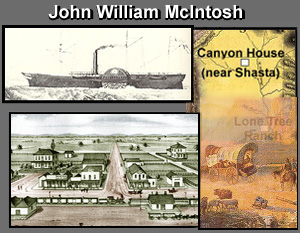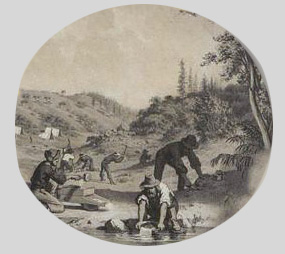 The following obituary appeared
in the
CHICO DAILY RECORD Thursday,
July 20, 1905
"John W. McIntosh
Taken By Death"
The following obituary appeared
in the
CHICO DAILY RECORD Thursday,
July 20, 1905
"John W. McIntosh
Taken By Death"
|
Was one of those who in early
days came West in quest for gold... Twice made Trips Across the
Plains Before the Day of Railroads Funeral Takes Place This Morning - - - - - - - - - John W. McIntosh, known to
nearly all the old residents of this part of the State, died
yesterday morning at the Burke Sanitarium in Sonoma County. His
illness had been of considerable duration, and death was not
unexpected. John William McIntosh was born in Greenup County,
Kentucky, July 16th, 1825. In 1850 with a party from Cythiana,
Ky., he came to California, locating first at Diamond Springs,
El Dorado County, where he engaged in mining, and in 1851 removed
to Trinity, still following mining. In the fall of 1851 he returned
to the East by way of Panama, sailing from San Francisco in the
historic steamer "Tennessee." He returned again to
California in 1852, crossing the plains with his father, mother,
sisters and brothers, arriving in Sacramento July 17th. The family
immediately thereafter located at the Lone Tree Ranch in Colusa
(now Glenn) county, and the various members of the family were
all closely identified with the early history and development
of Colusa. For many years he engaged in farming, residing for
ten years of the period in Chico, removing from here some twenty
years ago to Nelson, where he lived up to the time of his death.
He was married November 4, 1855, in Colusa County to Miss Elizabeth
Molter, who, during almost half a century, has been a devoted
wife and mother, and who survives him, together with a son, L.A.
McIntosh, the well known mining man of Shasta County, and two
daughters, Mrs. T.H. Barnard of Chico and Mrs. F.R. Stansell
of Nelson. He is also survived by a brother, L.H. McIntosh, and
two sisters, Mrs. George F. Jones of Chico and Mrs. A.M. Barnard
of San Francisco. He was a member of Chico Lodge of Odd Fellows.
John William McIntosh was a landmark of Butte and Colusa counties,
one of that hardy race of pioneers whose ranks are being so rapidly
thinned by death. In his business relations honest and trusting,
with a deep human sympathy and a faith in the integrity of others
that though often taken advantage of to his pecuniary loss, was
never lessened. Genial in his intercourse with his fellow men,
he leaves behind him none save pleasant memories, and at the
end of eighty years goes to his rest holding the respect of all.
The remains of deceased arrived in Chico on this morning's express.
The funeral will take place at 10 o'clock this morning from the
Presbyterian Church, under the auspices of Chico Lodge No. 118
I.O.O.F., in which he was a member. |
Here is an illustrated version of the same obituary,
with extra notes
|
"In 1850 with a party from Cythiana,
Kentucky, he came to California, locating first at Diamond Springs,
El Dorado County, where he engaged in mining, and in 1851 removed
to Trinity, still following mining."

|
See the biography of John's nephew John Francis Cooper for more details about their trip in 1849. |
|
|
John William McIntosh's first
stop was the end of the trail:
Diamond Springs, El Dorado
County, California |
Diamond Springs
|
This is an 1850's era building
still standing in Diamond Springs. The town is a short distance
south of Hangtown, known today as Placerville. |
|
|
"In the fall of 1851
John returned to the East by way of Panama, sailing from San
Francisco in the historic steamer "Tennessee." |
|
The Steamship Tennessee
The Tennessee was the first American steamship whose service
was interrupted to be used in the Panama run. She was provisioned
for a Pacific voyage by way of the Straits of Magellan and on
her first run, because of storms, she carried only 15 passenger,
passing the equator on Dec. 23, 1849. When she reached Panama
on March 12, 1850 after 57 days at sea from New York, she was
met by 3,000 people waiting for passage to San Francisco.
The SS Tennesse brought thousands of gold-seekers to the
City before sinking just outside of San Francisco's fog-shrouded
headlands on March 6, 1853 in an area on the Marin County coast
which is now named Tennessee Cove in her honor. Her passengers,
mail and baggage were saved, but she was a total loss. |
|
In the fall of 1851 John
William McIntosh crossed the Isthmus of Panama on his way back
to Kentucky to get his family. |
|
The shortcut across Panama required travel through fever-infested
jungles. Many gold-seekers died while waiting for the next ship
to get them safely back to the United States. Disease killed
many in California in those days, as well. |
|